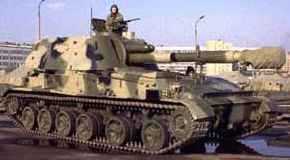Articles >>
Self-propelled Gun
Category: Term of the day

A self-propelled gun is a gun, whether it be an artillery piece, anti-tank gun, or anti-aircraft gun, mounted on a motorized wheeled or tracked chassis. As such the gun can be manoeuvred under its own power as opposed to a towed gun that relies upon a vehicle or other means to be moved on the battlefield. Self-propelled guns are combat support weapons; they are employed by combat support units fighting in support of, or attached to, the main combat units: infantry and armour. It may be armoured, in which case it is considered an armoured fighting vehicle. Although the two are superficially similar self-propelled guns should not be confused with tanks. As a rule self-propelled guns are more lightly armoured and without turrets. Tanks are armed with guns designed specifically to destroy other tanks while only true of some types of self-propelled guns are designed for anti-tank warfare.
Some self-propelled guns are used as artillery pieces in a similar manner to traditional towed howitzers and as such also fall under the umbrella description of self-propelled artillery, but the two terms are not the same and the one is not a sub group or specialization of the other.
The greatest tactical advantage in the case of artillery guns is clearly the greater degree of mobility they have compared to towed artillery. Not only is it important in offering military forces greater flexibility, but it is critical in avoiding attack from the enemy (counter-battery fire) by allowing the guns to change position immediately after firing one or more salvoes and before their position can be located ("shoot-and-scoot" tactics). A secondary advantage in the case of armoured – even lightly – guns is the increased protection offered to the gun crews. |
KORKUT Serial Production Begins
23.03.2017
Tigr at Tank Days in Slovakia
12.07.2016
Discuss
